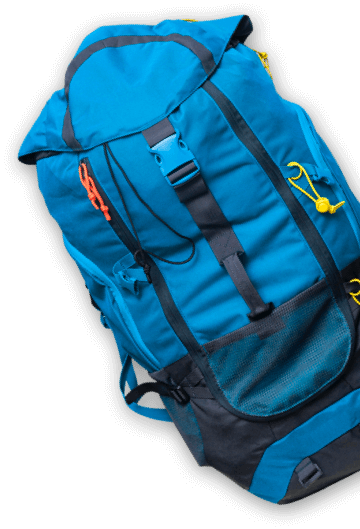04 Aug 20
Which stage of the Camino should I walk?
Are you asking yourself which stage of the Camino you should walk? Read on for a breakdown of five sections to help you decide.
The Camino Frances is approximately 800km long, with variations depending on your source of information. With a handful of recommended rest days, this would take the average person around six weeks to complete. It’s fair to say not everyone has six weeks spare to take off and go and walk the Camino.
With a limited time frame to work with, the inevitable question arises, which section, or sections of the Camino should I walk? The automatic response would be, how long is a piece of string? Like most things in life, the answer to this is dependent on your point of view and what’s important to you. Based on this, we will try and summarise what to expect from each section in the hope of clearing the muddy waters and helping you decide which section or sections are best for you.
Camino Frances Stage 1
St Jean Pied De Port to Logrono
This section has a bit of something for everyone, but it kicks off with a bang! Day 1 is arguably the most strenuous days walk of the whole Camino. But you are rewarded with some of the most spectacular scenery of the whole Camino. You start off with a straight-up climb out of St Jean which doesn’t really ease off until the final descent into Roncesvalles.
Along the way, subject to clear weather (which is by no means a given), you will see spectacular scenes across the Pyrenees mountains. Roncesvalles itself is an almost mystical mountain village with little more than a couple of accommodation and eating options, and a population of, wait for it, 20! The lovely scenery continues on down into Zubiri and through to the outskirts of Pamplona. Pamplona is a buzzing, vibrant city and is a perfect first rest day.
Coming out of Pamplona you cross one of the most iconic sights of the Camino, Alto del Perdon, with its cast iron pilgrim cutouts and wonderful views. Puente La Reina (The King’s Bridge) is another familiar Camino scene followed by the delightful town of Estella. More highlights of this section include the wine fountain of Irache (yes, free wine on tap!), the quintessential Camino towns of Los Arcos and Viana, and finishing in the capital of La Rioja province in Logrono.
CONSIDERATIONS: Spectacular scenery, iconic Camino sights, mountains, lovely Camino towns, some arduous walking.
Camino Frances Stage 2
Logrono to Burgos
This section is dominated by vineyards as you enter into the wine growing region of La Rioja. Starting off in its capital, Logrono, you might like to take a day off here and do a wine tour. Logrono itself is nice enough but probably not interesting enough to warrant a rest day unless doing a tour.
Although there are no real mountains in this section, there are a few fairly steep climbs. And if you’re unfortunate enough to walk this section in the wet you will undoubtedly discover the region’s identifying feature- sticky, clinging, clay-like mud!
CONSIDERATIONS: Vineyards, clay, lack of iconic sights or towns, some ascents.
Camino Frances Stage 3
Burgos to Leon
Known as the Meseta, this is undoubtedly the most underrated of sections. Flat, boring, featureless, shadeless… sounds great doesn’t it?! Although this description is accurate, it is also the section where you could have some of your biggest breakthroughs, your true epiphanies and break through some of your biggest conundrums.
With little to distract you, your thoughts take centre stage. If self-discovery and introspection is your Camino goal then this section is a must. For more details, you can read more on this section here.
CONSIDERATIONS: Long lonely walking days, hot and sunny in summer, featureless, almost dead flat, great for introspection.
Camino Frances Stage 4
Leon to O Sarria
Arguably the pick of the sections, with Camino moments and towns aplenty. Starting in the fascinating and scenic city of Leon, once you make it past the suburbs you will stay in such superbly Camino towns as Astorga and Villafranca del Bierzo. Next up are delightful mountain towns like Rabanal del Camino and O Cebreiro.
Mountains and stunning scenery abound with some very steep climbs. But the true highlight of this section is the poignant Cruz de Ferro, or Iron Cross. This is where you lay a stone brought from home at the foot of the cross to symbolise the shedding of a burden. It can be a tribute to a passed loved one, or anything you wish it to symbolise.
CONSIDERATIONS: Mountain scenery, some steep climbs, delightful towns, iconic Camino moments.
Camino Frances Stage 5
Sarria to Santiago
Although not packed with highlights like some sections, the final 115km from Sarria to Santiago is by far the most popular section due to it being the final section walking into Santiago de Compostela, as well as being the minimum amount of kilometres needed to walk to obtain a Compostela, or certificate of completion.
The walking isn’t difficult on this section with just gradual inclines as opposed to sharp climbs. Due to its popularity, there is a real community feel. It’s a cultural melting pot and you will make friends with people from all walks of life (excuse the pun!) and countries. And of course you get to experience the crowning glory of walking into Santiago de Compostela as the pinnacle of this section, and potentially all sections!
CONSIDERATIONS: Relatively easy walking, increased numbers walking, few iconic Camino towns or experiences, receive Compostela.
Want More…
Only two weeks on the Camino?
A few inspirational options to consider.
The meaning of the stone crosses on the Camino
‘Cruceiros’ (stone crosses) are placed strategically all over the Galicia’s countryside.

